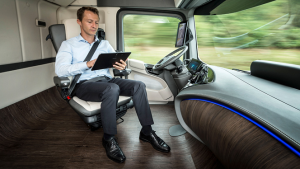
Companies are struggling to redefine their staffing models in light of the new FLSA changes. Does this mean we will need more knowledge workers, and less traditional blue collar workers? Let's explore this a bit more.
The Traditional Hourly Worker
We typically think about hourly workers as blue collar employees. These are the unsung heroes who clean our hotel rooms, cook and serve our restaurant meals, and deliver/stock our stores. They are the core of the service industry's staffing model.
But what happens if we deploy technology to replace some of these functions?
- Maidbot is a start-up that was founded in Ithaca, New York. It’s mission is to provide safe and cost-efficient automated solutions to the hospitality industry and is developing robotics to replace housekeepers.
- Semi-autonomous trucks are expected to replace one-third of all long haul trucks by 2025.
- Quick serve restaurants like McDonalds and Panera bread have already replaced cashiers with kiosks. Momentum Machines is working hard to bring the price of a fully autonomous kitchen from $75,000 down to $15,000, which will make this technology deployable across the fast food industry.
A few things may not change. Robots may be able to make burgers and clean floors, but a real live human (at least as of today) still needs to make sure the location is safe, that the kitchen is stocked, and to take out the garbage. With autonomous trucks, someone still needs to open a trailer door and unload the vehicle.
Will Tech be Accepted?
There’s a lot of media coverage about the pros and cons of autonomous vehicles. It’s akin to when the horse-and-buggy was replaced by the car. At first people were scared of the technology, and it was deemed unsafe. The same thing is happening now. Tesla’a autopilot lead to a series of crashes, which promoted Consumer Reports to decry the feature “Too Much Autonomy Too Soon.” Meanwhile, Uber is testing autonomous rides.
If nothing else, humans can adapt to technology quickly. Cars lead to planes, and now we rely on autopilot during flight. So why are we so freaked out by autopilot in our cars? It’s the old horse-and-buggy versus the car dynamic. Within a few years we won’t think twice about having a driverless car roll up and take us to our destination.
Some jobs will always require a human touch. A robot may be able to make a safe, consistent burger, but I still want a real live human to hold my hand when I get a shot. There’s also no substitute (at least yet) for real live human theatrical productions or fine dining experiences. But I’ll sign up for that autonomous car as soon as it’s available.
The Future Hourly Worker
As technology continues to develop, we’ll have the capability to autonomously provide transport, unload vehicles, stock shelves, and take out the trash. So what will happen to traditional blue collar workers? Will they have a place in a company's staffing model?
We predict that many of today’s housekeepers, drivers, and cooks will become knowledge workers. Knowledge workers can manage robotics and data – if they’re qualified. Our challenge is to make sure that our educational system can churn out the knowledge workers we need to support robotics in industry.
In the past, we relied on vocational trade schools to train welders, truckers, and other entry level blue collar workers. Unfortunately funding for many of these programs disappeared from federal and state budgets. Companies found it increasingly difficult to stay staffed with skilled workers. Some companies gave up on public education funding and started their own truck driving and welding schools.
Let’s hope that our legislatures don’t make the same mistakes with knowledge workers. Here’s a snippet from the Pew Research Center that notes that US students are improving – slowly – in math and science, but are still lagging behind their international counterparts:
In a new Pew Research Center report, only 29% of Americans rated their country’s K-12 education in science, technology, engineering and mathematics (known as STEM) as above average or the best in the world. Scientists were even more critical: A companion survey of members of the American Association for the Advancement of Science found that just 16% called U.S. K-12 STEM education the best or above average; 46%, in contrast, said K-12 STEM in the U.S. was below average.
Will Pay Rise?
So, let’s assume that we replace housekeepers, drivers, and cooks with robots. What does that mean in terms of knowledge worker pay? It stands to reason that as the market demands more knowledge workers, pay should rise. It’s also possible that as we continue to evolve into a tech based economy, the burger flipper of today may become the knowledge worker of tomorrow. We predict that the brightest and most adaptable knowledge worker will be in demand as much as today’s developers are.
But that doesn’t mean that all blue collar jobs will disappear. As of today, robotics only works well when deployed in repetitive environments. We’re not ready to deploy robotics to replace your roof, care for our loved ones, manage yards, or perform the countless other tasks that today’s traditional blue collar worker does. Perhaps “handcrafted” will take on a new meaning as custom tasks demand real live humans at a premium rate.